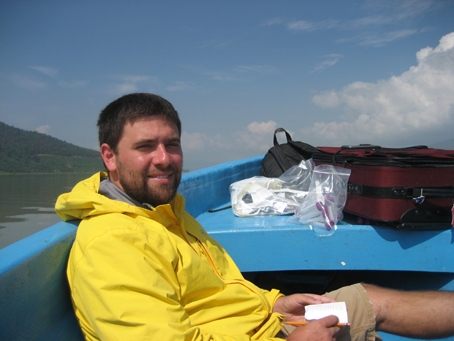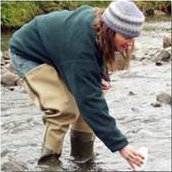NCER's mission is to support high-quality research by the nation's leading scientists and engineers that will improve EPA’s scientific basis for decisions on national environmental issues. NCER supports leading edge extramural research in exposure, effects, risk assessment, and risk management through competitions for STAR grants, fellowships, and research contracts under the Small Business Innovative Research Program. Learn More
Special Announcements
Top Stories
 Algal Blooms in the Environment
Algal Blooms in the Environment
We have all witnessed the pond, lake or stream that is covered by foam, scum or a mat of algae. Don’t swim! Don’t drink! And who would want to? One of the common culprits of this problem is cyanobacteria, also called blue-green algae. Technically, they are classified as bacteria because they have some characteristics of plants, namely the ability to photosynthesize.
[Read More]
 Indoor Air Particles Increase Asthma Symptoms in Children
Indoor Air Particles Increase Asthma Symptoms in Children
Researchers at Johns Hopkins found a direct correlation between increasing concentrations of particulate matter (PM) in indoor air and increased asthma symptoms in preschool children. Funded in part by a grant from EPA’s Science to Achieve Results program and the National Institute of Environmental Health Sciences (NIEHS), the study, published in the February issue of Environmental Health Perspectives, evaluated 150 inner city children with asthma in the Baltimore metropolitan area.
[Read More]
 Small Businesses Receive Contracts for Green Technology
Small Businesses Receive Contracts for Green Technology
(Washington, D.C. – Feb. 20, 2009) - The U.S. Environmental Protection Agency awarded $1.6 million in contracts to 23 small companies to assist their efforts to bring promising new green technologies to market. This award is part of EPA’s Small Business Innovation Research (SBIR) program, which helps small business throughout America develop technologies that are more protective of our air and water quality and promote alternative sources of energy.
[Read More]
 University of Iowa Receives $899,401 Research Grant to Develop Better Air Quality Estimates for U.S. Cities
University of Iowa Receives $899,401 Research Grant to Develop Better Air Quality Estimates for U.S. Cities
(Kansas City, Kan., Feb. 17, 2009) - EPA's National Center for Environmental Research has awarded a $899,401 grant to the University of Iowa for a research project that will develop techniques to identify the most harmful fractions and sources of air particulate matter in major U.S. cities, including Chicago.
[Read More]
 University of Nebraska-Lincoln Receives $372,982 Grant to Improve Toxicity Testing of Genetically-Engineered Foods
University of Nebraska-Lincoln Receives $372,982 Grant to Improve Toxicity Testing of Genetically-Engineered Foods
(Kansas City, Kan., Feb. 17, 2009) - EPA's National Center for Environmental Research has awarded a $372,982 grant to the University of Nebraska-Lincoln for a research project designed to improve the testing of genetically-engineered foods.
[Read More]
 Protecting Our Streams in Ski Country
Protecting Our Streams in Ski Country
Love to ski? Enjoying breezing down the powdery snow on a crisp winter day and then retreating to the lodge for a warming libation? Something that good must have a downside….and if you haven’t thought about whether the pristine mountain streams are degrading from accelerated population growth and poor land-use planning, we are lucky to have STAR fellow Kristin Gardner worrying for us.
[Read More]
 Hey Nation! – Stephen Colbert spreads the WORD about "Cheating Death" using EPA's particulate matter research!
Hey Nation! – Stephen Colbert spreads the WORD about "Cheating Death" using EPA's particulate matter research!
In a recent "Cheating Death" segment of Comedy Central's Colbert Report, Stephen Colbert discussed a new study published in the New England Journal of Medicine which found that breathing cleaner air can extend your life span.
[Read More]
 Two Funding Opportunities Now Open under EPA and NIEHS Joint Children's Environmental Health Centers Program
Two Funding Opportunities Now Open under EPA and NIEHS Joint Children's Environmental Health Centers Program
NIEHS and EPA have jointly issued two funding opportunities to support the next phase of the Children’s Environmental Health Research Centers (CEHCs) program.
[Read More]
 Research Suggests Reductions in Particulate Air Pollution May Lead to Increased Life Expectancy
Research Suggests Reductions in Particulate Air Pollution May Lead to Increased Life Expectancy
Researchers funded in part by an EPA STAR grant have found that life expectancy can be increased by breathing cleaner air.
[Read More]
 Algal Blooms in the Environment
Algal Blooms in the EnvironmentWe have all witnessed the pond, lake or stream that is covered by foam, scum or a mat of algae. Don’t swim! Don’t drink! And who would want to? One of the common culprits of this problem is cyanobacteria, also called blue-green algae. Technically, they are classified as bacteria because they have some characteristics of plants, namely the ability to photosynthesize.
[Read More]
 Indoor Air Particles Increase Asthma Symptoms in Children
Indoor Air Particles Increase Asthma Symptoms in ChildrenResearchers at Johns Hopkins found a direct correlation between increasing concentrations of particulate matter (PM) in indoor air and increased asthma symptoms in preschool children. Funded in part by a grant from EPA’s Science to Achieve Results program and the National Institute of Environmental Health Sciences (NIEHS), the study, published in the February issue of Environmental Health Perspectives, evaluated 150 inner city children with asthma in the Baltimore metropolitan area.
[Read More]
USDA and EPA Announce $4.5 Million Available for Research on Ecosystem Services provided by Agricultural Lands
The USDA and USEPA are seeking applications proposing research on the ecosystem services provided by agricultural lands. Agroecosystems provide essential services such as food, fuel, fiber, nutrient cycling, retention of soils and sediments, mitigation of flood damage, climate-change regulation, and protection of biodiversity (MEA 2005). New research, models and other analytical tools are needed to assess how the pattern, connectivity, and management of agroecosystems could enhance the production of other services (e.g., enhanced habitat and biodiversity, carbon sequestration, control of invasive species, and natural control of crop pests) while reducing undesirable impacts like non-point source pollution, eutrophication of surface waters and degraded groundwater and air quality.
[Read More]
The USDA and USEPA are seeking applications proposing research on the ecosystem services provided by agricultural lands. Agroecosystems provide essential services such as food, fuel, fiber, nutrient cycling, retention of soils and sediments, mitigation of flood damage, climate-change regulation, and protection of biodiversity (MEA 2005). New research, models and other analytical tools are needed to assess how the pattern, connectivity, and management of agroecosystems could enhance the production of other services (e.g., enhanced habitat and biodiversity, carbon sequestration, control of invasive species, and natural control of crop pests) while reducing undesirable impacts like non-point source pollution, eutrophication of surface waters and degraded groundwater and air quality.
[Read More]
 Small Businesses Receive Contracts for Green Technology
Small Businesses Receive Contracts for Green Technology(Washington, D.C. – Feb. 20, 2009) - The U.S. Environmental Protection Agency awarded $1.6 million in contracts to 23 small companies to assist their efforts to bring promising new green technologies to market. This award is part of EPA’s Small Business Innovation Research (SBIR) program, which helps small business throughout America develop technologies that are more protective of our air and water quality and promote alternative sources of energy.
[Read More]
 University of Iowa Receives $899,401 Research Grant to Develop Better Air Quality Estimates for U.S. Cities
University of Iowa Receives $899,401 Research Grant to Develop Better Air Quality Estimates for U.S. Cities (Kansas City, Kan., Feb. 17, 2009) - EPA's National Center for Environmental Research has awarded a $899,401 grant to the University of Iowa for a research project that will develop techniques to identify the most harmful fractions and sources of air particulate matter in major U.S. cities, including Chicago.
[Read More]
 University of Nebraska-Lincoln Receives $372,982 Grant to Improve Toxicity Testing of Genetically-Engineered Foods
University of Nebraska-Lincoln Receives $372,982 Grant to Improve Toxicity Testing of Genetically-Engineered Foods (Kansas City, Kan., Feb. 17, 2009) - EPA's National Center for Environmental Research has awarded a $372,982 grant to the University of Nebraska-Lincoln for a research project designed to improve the testing of genetically-engineered foods.
[Read More]
 Protecting Our Streams in Ski Country
Protecting Our Streams in Ski CountryLove to ski? Enjoying breezing down the powdery snow on a crisp winter day and then retreating to the lodge for a warming libation? Something that good must have a downside….and if you haven’t thought about whether the pristine mountain streams are degrading from accelerated population growth and poor land-use planning, we are lucky to have STAR fellow Kristin Gardner worrying for us.
[Read More]
Understanding the Role of Nonchemical Stressors and Developing Analytic Methods for Cumulative Risk Assessments
$8 Million EPA STAR research competition opens on role of non-chemical stressors and analytic methods for cumulative risk assessments. RFA calls for research on techniques to analyze disparate data types, and evaluate the combined effects of nonchemical and chemical stressors on communities.
[Read More]
$8 Million EPA STAR research competition opens on role of non-chemical stressors and analytic methods for cumulative risk assessments. RFA calls for research on techniques to analyze disparate data types, and evaluate the combined effects of nonchemical and chemical stressors on communities.
[Read More]
 Hey Nation! – Stephen Colbert spreads the WORD about "Cheating Death" using EPA's particulate matter research!
Hey Nation! – Stephen Colbert spreads the WORD about "Cheating Death" using EPA's particulate matter research!In a recent "Cheating Death" segment of Comedy Central's Colbert Report, Stephen Colbert discussed a new study published in the New England Journal of Medicine which found that breathing cleaner air can extend your life span.
[Read More]
 Two Funding Opportunities Now Open under EPA and NIEHS Joint Children's Environmental Health Centers Program
Two Funding Opportunities Now Open under EPA and NIEHS Joint Children's Environmental Health Centers ProgramNIEHS and EPA have jointly issued two funding opportunities to support the next phase of the Children’s Environmental Health Research Centers (CEHCs) program.
[Read More]
 Research Suggests Reductions in Particulate Air Pollution May Lead to Increased Life Expectancy
Research Suggests Reductions in Particulate Air Pollution May Lead to Increased Life ExpectancyResearchers funded in part by an EPA STAR grant have found that life expectancy can be increased by breathing cleaner air.
[Read More]
Upcoming Events
- Remediation Technology Summit (REMTEC) 2009: The Future of Remediation Technology - March 5 - 9 2009
- 237th ACS National Meeting Symposium on Nanotechnology and the Environment: Emphasis on Green Nanotechnology - March 22 - 26 2009
- SBIR Workshop: Ames, Iowa in collaboration with USDA and hosted by states of Iowa and Nebraska - March 26, 2009
![[logo] US EPA](https://webarchive.library.unt.edu/eot2008/20090304232546im_/http://www.epa.gov/epafiles/images/logo_epaseal.gif)